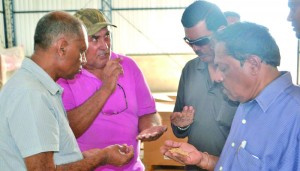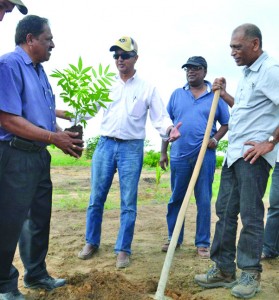In a little known Region Nine area, nestles Santa Fé, which in English translates to Holy Faith. It is an area that will surely amaze persons who see it for the first time. In this remote interior savannah, Santa Fé is blossoming, bringing forth, fruits, vegetables, ground provisions and more importantly, rice. Santa Fé is a mega farm project undertaken by the Simpson Group of Companies of Barbados, and in June, it is expecting a bumper rice crop. Thus far, 120 acres of rice is being cultivated.

The project, being managed by Guyanese Richard Vasconcellos, is rapidly moving apace.
Vasconcellos told Guyana Times International that Santa Fé, which is part of the Simpson Group of Companies, became a reality in Guyana as a direct result of the Jagdeo Initiative, following calls for more investment in the agriculture sector in the region.
He said the decision was also influenced by Guyana’s availability of land and water, its established system of democracy, stable currency and openness for business.
The Simpson Group of Companies is the Caribbean’s largest independent distributor of automobiles and the region’s largest independent oil company.
Recently, Agriculture Minister Dr Leslie Ramsammy, junior Agriculture Minister Alli Baksh and a team from the ministry journeyed to Region Nine where they visited and interacted with the Blue Wave investors and staff at the mega farm.
Employment
Minister Ramsammy said he heard a lot of people saying that the Jagdeo Initiative is a waste of time, however, at Santa Fé there are rice, fruits, vegetables and ground provision being produced and pump stations and other facilities being constructed to accommodate other services.
Importantly, the venture is being undertaken through a combination of local and international expertise. Of the 60 employees on the site, 57 are Guyanese from Region Nine and the remainder are Brazilian consultants.
Jagdeo initiative
“The Jagdeo Initiative was intended for food security and nutrition security in the Caribbean… Santa Fé is one of the first examples of Caribbean people responding to (former) President Jagdeo’s call to invest in agriculture in our country,” Minister Ramsammy said.
He thanked the Simpson family from Barbados for responding to Guyana’s call.
Discussions and the strategy established for this project commenced in 2010 with former President Bharrat Jagdeo. “This is another example not only of the Jagdeo Initiative working, but the amount of food that will be produced at Santa Fé will be beyond anything that Region Nine can consume, and therefore Santa Fé is meeting another objective of the Jagdeo Initiative which is that Guyana becomes firmly established as the food basket of the Caribbean,” Minister Ramsammy emphasised.
Further, in meeting that obligation, it shows that every part of Guyana can play a role, and in so doing, they would be adding to the country’s portfolio as an export nation.
1000 acres
Along with the cultivated areas, Santa Fé has almost completed the establishment of a state-of-the-art rice factory coupled with huge silos which will be used to store the paddy harvested from these large fields.




